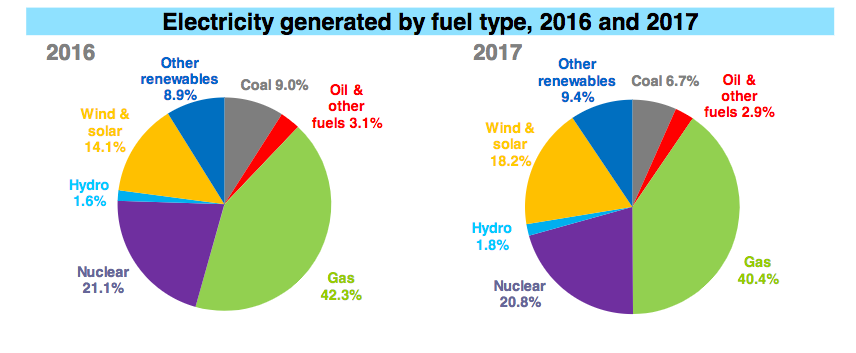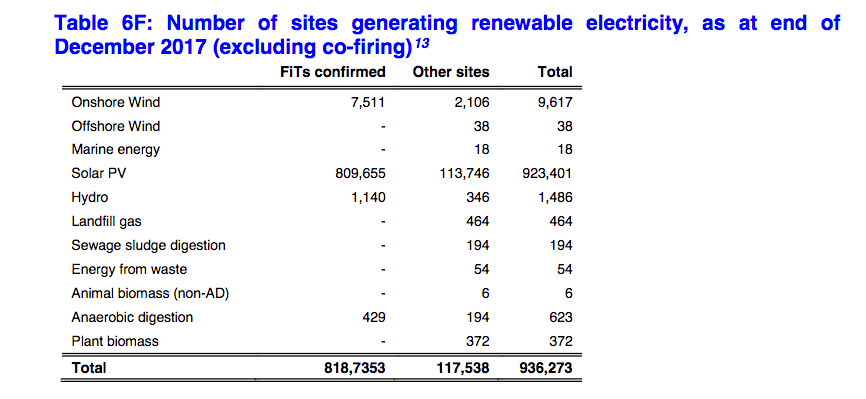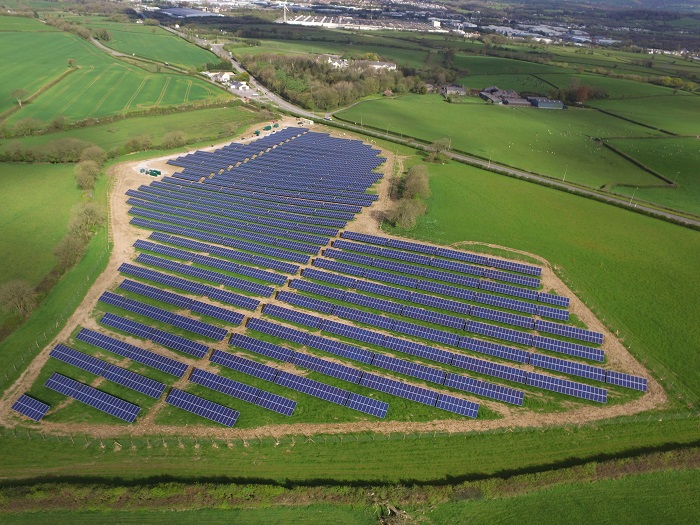Despite the continuing onslaught of bad energy news in the U.K., including a proposal to end solar export tariffs for homeowners next year, and the approval of fracking in Lancashire – in the face of fierce opposition – renewables are doggedly continuing on their path to dominance.
The government has just released its ‘Digest of United Kingdom Energy Statistics 2018’, which shows that while fossil fuels were still clearly the leading source of electricity generation in the U.K. last year, at 80.1%, their grip is loosening, with renewables increasingly picking up the slack.

“In 2017, there was a switch in the main sources of electricity generation away from coal and gas to renewables,” wrote the report’s authors. Indeed, generation from coal and gas fell by 27% and 4.6%, respectively, while renewables grew 19.5%. Overall, renewables contributed to 29.3% of total electricity generation, compared to 24.5% in 2016.
“Onshore wind was the leading technology in terms of capacity at 31.7 per cent. Although solar photovoltaics saw a further increase in capacity, it was insufficient to retain the leading technology status in 2017 with a 31.5 per cent share,” said the report. This still marks an 11% increase for solar PV, however.

“This compares with a doubling of [solar PV] generation in 2014, 86 per cent growth in 2015, and 38 per cent in 2016,” continued the report, adding, “This is in line with a slowing in the growth of capacity which increased by just 7.3 per cent to 12.8 GW in 2017. New schemes include, Henley Hall (22 MW), Lough Road PV (32.13 MW) and Bann Road PV (includes second Bann record) (45.75 MW).”
Favorable conditions
The growth in renewables was due to increased generation capacity, particularly for wind (22.6%) and solar (7.3%), and favorable weather conditions for wind.

“The load factor for solar photovoltaics (on an unchanged configuration basis) decreased slightly in 2017, by 0.4 percentage points to 10.7, the lowest since 2011,” continued the report. “This reflects the slightly lower hours of sunshine (4.1 hours compared to 4.2 for 2016). Compared to the ten year mean, hours of sunshine in 2017 were fewer for most months during the apart from January, November and December.”
It added, however, that there are fluctuations, and that on Saturday, March 25, demand on the National Transmission System was, for the first time, lower in the afternoon than overnight. This was due to “very high” levels of PV generation.
Popular content
“This will become common place in future summer days with implications for management of the grid and for operation of fossil fuelled plant,” said the report.
Making waves
In line with this, and on the back of the current heat wave in the U.K., particularly in England, 2018 could be on track to see solar’s share increase significantly.
Non-profit service, MyGrid GB, which charts the changes in electricity generation in the U.K., recently reported that the country had surpassed 1,000 hours without coal already this year, and that between June 21-28, solar PV saw over 75 GWh of energy generated, and created over 8 GW of power each day, for eight consecutive days – a new record.
Meanwhile, Sunday, June 24 saw solar PV generating over 27% of electricity for the U.K. grid for around one hour.
The latest figures from MyGrid GB show that in the last seven days, solar was the leading renewable energy in the country, contributing 7.1% to electricity generation, behind gas (45.9%), nuclear (24.1%) and imports (9.3%).
Decreasing CO2 emissions
The growth of renewables in the U.K. has helped drive a “sharp decrease” in CO2 emissions between 2016 and 2017, reports the government, with provisional estimates by the Department of Business, Energy and Industrial Strategy (BEIS) indicating that emissions have dropped by 12 million tons – 3.2% – to 366.9 MtCO2.
With the progress made – in 2016, renewables were said to have provided nearly a quarter of the country’s electricity generation – the government says the U.K. is on track to “comfortably exceed” its goal of renewables supplying 30% of the country’s electricity by 2020-21.
Let’s just hope it bucks up and provides the much needed clarity on the policy framework for renewables, and more specifically, solar PV, post feed-in tariffs.
This content is protected by copyright and may not be reused. If you want to cooperate with us and would like to reuse some of our content, please contact: editors@pv-magazine.com.



By submitting this form you agree to pv magazine using your data for the purposes of publishing your comment.
Your personal data will only be disclosed or otherwise transmitted to third parties for the purposes of spam filtering or if this is necessary for technical maintenance of the website. Any other transfer to third parties will not take place unless this is justified on the basis of applicable data protection regulations or if pv magazine is legally obliged to do so.
You may revoke this consent at any time with effect for the future, in which case your personal data will be deleted immediately. Otherwise, your data will be deleted if pv magazine has processed your request or the purpose of data storage is fulfilled.
Further information on data privacy can be found in our Data Protection Policy.